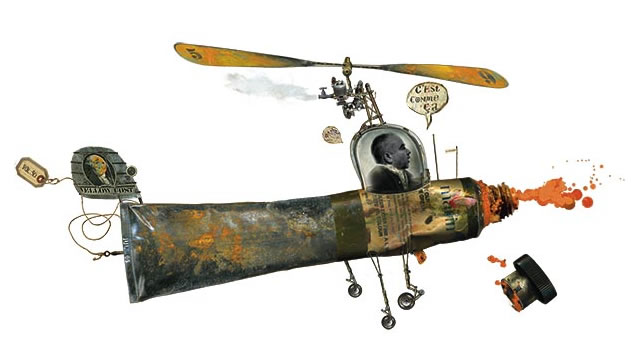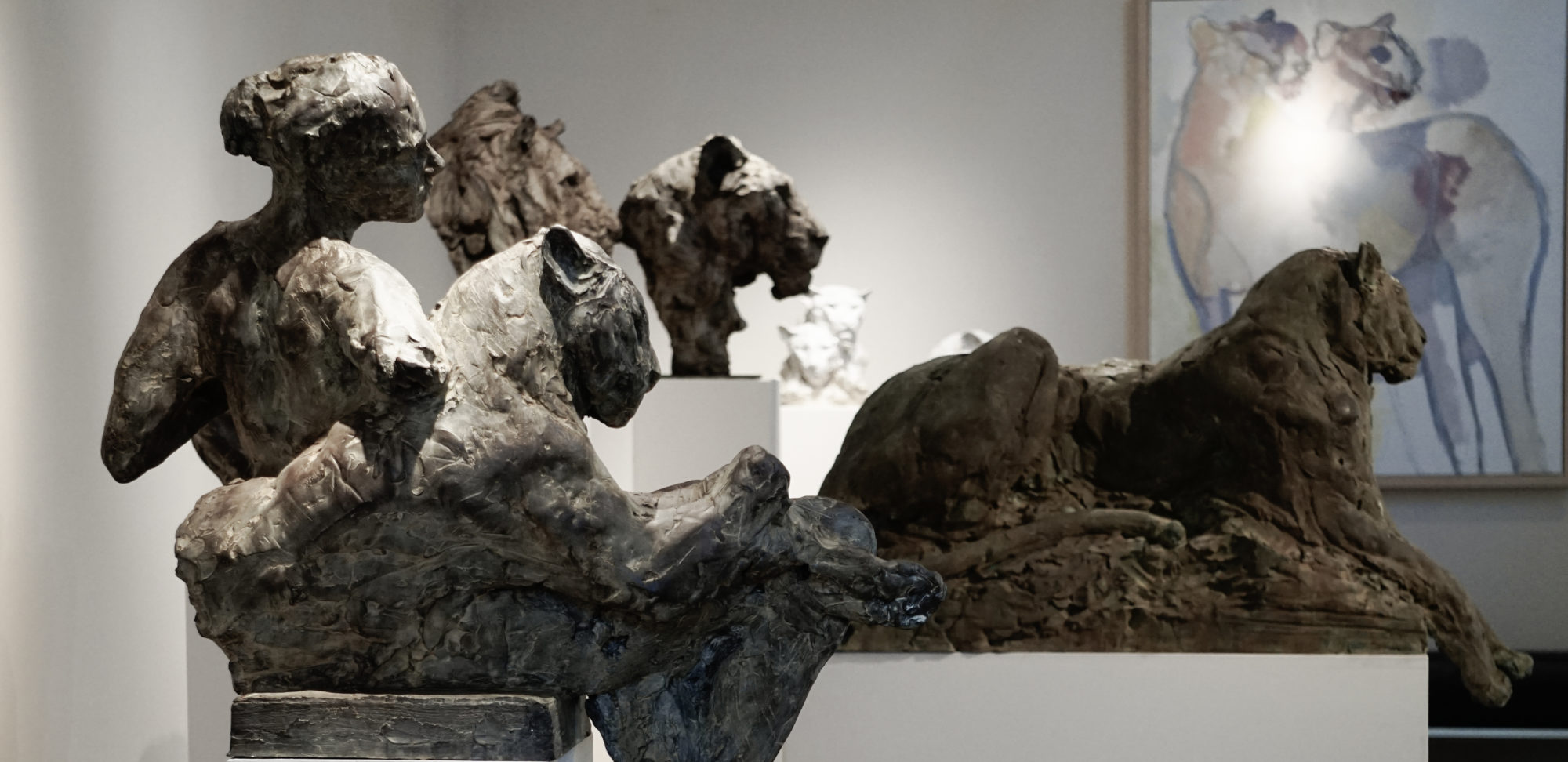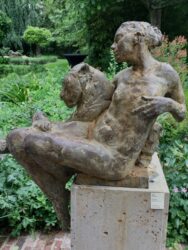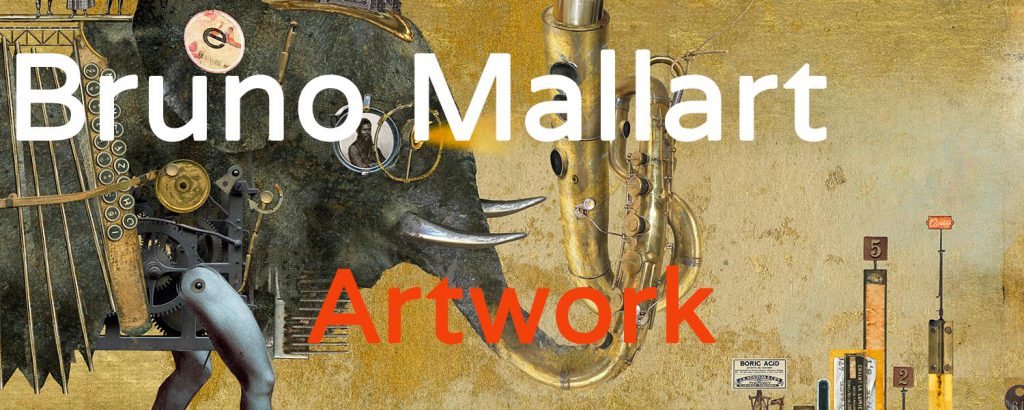BRUNO IN MALLARDOLAND: Interview by Karen Haber
Realms of Fantasy
Welcome to Mallardoland! Don’t be afraid to enter: it’s free. All that’s required is a healthy sense of the absurd. Mallardoland is the place where Alice in Wonderland wears a CD for a skirt, harpsichords feature teeth instead of keys, smiling cats have deviled eggs for eyes, and Jules Verne may be kidnapped by a runaway teapot with an elephant’s trunk for a spout! Mallardoland is the cool and colorful website of the acclaimed French artist/illustrator Bruno Mallart, (Hint: He’s the one wearing the Napoleon Bonaparte hat on the first screen of the site.) It’s filled with strange animals, machineries of joy, specializes in flights of fancy. But it’s more than a website. Mallardoland is the place that Bruno Mallart spends most of his time: it’s located somewhere deep in his imagination, and is the wellspring from which he’s drawn inspiration to illustrate fantasy classics like ALICE IN WONDERLAND and children’s books, greeting cards, and publications in Europe and the U.S. , including Le Monde and The New York Times and The Wall Street Journal. His ingenious collages supply illustrations to the major publishers of his native France and for various clients around the globe. To get to Mallardoland type the following on your computer keyboard: http://www.brunomallart.com
Before you go, take a look below at some of Bruno’s comments in his Q & A with Realms of Fantasy.
Q: What makes you happy in your work?
BM: I like the idea of inventing a universe according to what passes through my head. We as humans have all this imaginative and creative ability, and I have the rare chance to be able to truly apply it in my trade. It’s work which calls mainly upon the imaginary. It’s the most important aspect of this work, much more than the technical side. If I could imagine my images and print them directly from my brain onto the sheet without having to pass them through my hands, I would be even happier.
Q: Have you always had a good sense of the absurd? Where did you get it? (Does anyone else in your family suffer from this malady?)
BM: I think that the whole world suffers from that malady! In my family, and elsewhere. Isn’t the world around us absurd? I ‘m not talking about the revolting things which take place on this planet. I mean to say that life, the mere fact that we are here, isn’t this an incongruous dream? I think that my questioning of reality dates from the moment — age 4 years, 3 months, 8 days — when I first started to think. I began to formulate my ideas on paper a bit later, at graphic art school, a very good school where attention to excellence took precedence over all other considerations. The atmosphere of permanent competition which reigned there, made me feel a bit out of place. In reaction, I started to develop in my work, an absurd style and slightly cynical humor. Later, while starting to work as an illustrator, I gave up this style to do more traditional work. But that began to annoy me and I returned to the first style.
Q: Your work is very playful, very surreal, very marvelous. What sort of reaction are you hoping to evoke from your viewers?
BM: When creating my images, I don’t think about their destination. I only try to satisfy myself. I don’t think of a possible reader/spectator, but of what I would like to see. Above all I must surprise and amuse myself. I suppose that by consequence the public will have the same reaction.
Q: How important is humor — and surprise — in your work?
BM: As I mention above, these qualities are the engines of my images. But under the humor something more serious always hides, I don’t always know what it is . All that I know is behind any form of humor, there is a questioning.
Q: There is often a great deal of movement — fascinating rhythm — in your illustrations. Do you consciously seek to portray kinetic elements in your work?
BM: Indeed, in my work, one regularly finds wheels and other rolling, moving objects. I don’t know why I can’t stop! It’s true that I am very attracted by all that is mechanical, (while being a poor mechanic!). One aspect of movement I find very beautiful, as in the movie “Modern Times” with Charlie Chaplin. But I also like the dirty, greasy, rusted side of an old machine, so my images also point out this aspect of mechanics.
Q: What challenges did you face when illustrating the famous fantasy tale ALICE IN WONDERLAND?
BM: This project had a quite precise goal. It was a commissioned project for a design agency that was celebrating its 20th anniversary and wanted to publish an original book for the occasion. One can notice, while looking closely, that there are all kinds of contemporary products inserted in the images. In fact the products were designed and drawn by this agency. My challenge was to find a fresh original approach to illustrate this tale dating from the 19th century, and also to find the ways that would allow me to insert objects into the images, such as boxes of medication, toothpastetubes or a biscuit snacks!
Q: What inspired you? Had you always wanted to illustrate ALICE?
BM: It’s true that this tale is one that has inspired many illustrators. I re-read “Alice” with special attention to its world of wonders. The savor of this tale lies in the dream and the absurdity, but especially in the humor of the English word games. Obviously one cannot translate this aspect into images. However I think that my graphic universe has a direct relationship with this particular form of narration. I could play with the author’s themes and substitute certain forms for others to create surprises.
Q: Did you intend to make it visually contemporary (i.e. by using a compact discs for Alice’s skirt, and to have the Cheshire Cat brushing his famous smile with toothpaste…) or were you just looking for unusual ways to portray the characters?
BM: Due to the nature of the commission, it was obvious and necessary to place Alice in a modern universe, However, like always in my work, there are elements of the past which surface. The rapport between the past and the present is what provides an unusual flavor to the work.
Q: Are there any other famous fantasy or fairy tales that you would like to illustrate?
BM: I have a project to illustrate the THREE LITTLE PIGS. It will be called THE THREE BIG PIGS, and will place this morality tale off-balance, making a delirious parody of it.
Q: Do you actively look for “found” objects to use in your collages?
BM: I am always interested in discovering strange new objects which could be useful to me in my collages. My friends know it and often become my emissaries when they visit flea markets and refuse sites. One of their latest lucky finds: a box of splendid old gilded buttons which will surely become the eyes d’ a hypothetical rhinoceros with pistons…
Q: Do you scan the actual objects (compact discs, Chesterfield cigarette packs, etc.) for use in your illustrations or do you paint them?
BM: These objects are obviously scannéd. The power of my creations precisely resides in the real elements of the collages, which amplify the composition. If I were to draw them myself, it would take too much time and the drawing would lose its savor.
Q: How often does a found object provide a major stroke of inspiration?
BM: In general, I don’t rely on one object to imagine a new drawing. Each time I find an object, say, an old document, It scan it in very high definition. (It’s necessary, of course that the scannable object be flat) I don’t like to use photographs as much because they don’t allow the diabolic definition of the scanner, and also because my work uses the prospect of photography in general. Once l scan an object, it joins the thousands of others that I have saved on my hard drive. This allows me to use all of them for new creations.
Q: Do you ever build your object/collages in three- dimensions?
BM: At one time, I painted pictures in open boxes. I like the idea of an image divided into several boxes. It gives the impression of telling a story as in a cartoon. Since then, I use the computer, with which I amuse myself thanks to its impressive graphics possibilities. I would very much like to move on to the 3rd dimension and to carry out sculptures in the style of my drawings. I’ve already put together a few not-so-bad objects along those lines.
Q: Have you ever made toys?
BM: No, never. Well, maybe once, when I was a teenager. My parents gave me a model of a wooden fishing vessel. It was very beautiful with its bent hull made of fine formed wooden rods. But once finished, I found it missed something. I added wheels to it and surmounted it with a delirious structure that made one think of an oil refinery! It became a sophisticated toy, useful for nothing and totally absurd, which cost me hundreds of hours of work.
Q: Which are your favorite images from your oeuvre?
BM: One of my preferred images is that representing a dog (that also takes after a cow) with the head of typewriter. l made it for the cover of a novel by Kate Atkinson, but it was rejected. Their loss!
Q: What do you enjoy more, illustrating books for children or adults, and why?
BM: I largely prefer to illustrate for adults. When I work for children, I must self-censor.
Q: Do you have favorite colors? What are they?
BM: I like all the colors even those which seem ugliest. There are no ugly colors, there are only badly selected color relationships. I have that problem with green: I like it but I don’t know how to use it well.
Q:Which artists inspire you?
BM: I am absolutely a fan of work of certain famed illustrators: Saul Steinberg, Ralph Steadman, Tulio Pericoli.
Q: Which animals?
BM: I love the round or massive animals, the tortoise, the rhinoceros, the elephant, the pig. In any case when I draw one, I add wheels, anda head which is not the animal’s original head. Don’t ask me why, I don’t know anything, but I can’t stop myself.
Q: Do you listen to music as you work, and if so, to what?
BM: Yes, I Iisten to music, songs with text, I like those that speak to me. And I often listen to the radio, where people not only speak but, if possible, say intelligent things. Here is another of the good sides of my trade: to be able to listen to stories while working.
Q: How has your training in architecture influenced your work?
BM: It gives me a good base from which to define space, and movement within that space. This applies well to drawing. On the other hand I do not believe that this foundation influenced my style directly. I even believe that the opposite could be true: if I had been an architect, I would have been completely influenced by my graphic designs.
Q: Why does fantasy appeal to children of all ages?
BM: We all like to be told stories, eccentric ones, if possible, which leave the ordinary behind. Children especially enjoy this, and know the difference between reality and imagination, but can easily combine them. There must be a kind of intellectual pleasure to it.
Q: Do you have a definition of fantastic and surreal?
BM: For me, there is a difference between the fantastic and the surreal. I see the fantastic as an invented parallel world, but one that functions in the same way as the real world. It may be populated by imaginary and odd magic creatures, but its universe has a logic similar to that of our reality. The surreal one calls upon another state of consciousness, where logic disappears in order to relate this realm with dreams and the unconscious. For example, I see ” The Lord of The Rings” by J.R.R. Tolkien as Fantastic and “The Voyage of Shihiro” by Miyazaki as a surreal story.
Q: Does fantastic art transcend cultural differences or is it culture-specific?
BM: Fantastic art, in the same way as any other type of fiction, is always based upon a specific culture. it often calls upon mythology and because of this it has a specific cultural root. The Tales from the Arabian Nights take root in the Arab & Persian culture, and the fantastic one in the Arthurian legends.
Q: If you could be any age, what would it be?
BM: As young as possible!!
Q: Do you prefer painting to using the computer, or vice versa?
BM: At the moment I clearly use the computer more. But I really don’t use it to draw, I achieve infinitely richer, richer results in traditional drawing or painting. My use of the computer I think of more like being in the kitchen: after scanning, I must mix diverse ingredients, which I transform, deform, cut… There are thousands of possibilities.
Q: What challenges do you face creating illustrations for international English-reading audiences?
BM: I am of French culture, but I’m often told that my style would function better in the English-speaking countries. I do not know if it’s true. I find that the trade d’ illustrator here or in the United States is exactly the same one. People function in the same way, It’s surely a globalized culture!
Q: Do you have any advice for young aspiring artists?
BM: Make what you like the way that you like it, immediately. I wasted much time at the beginning making drawings which I did not like, because I thought that what I liked to make was not commercial enough. I was mistaken, obviously.
Q: Do you recommend that they visit “Mallardoland?” (Your website…)
BM: ¡como no!



